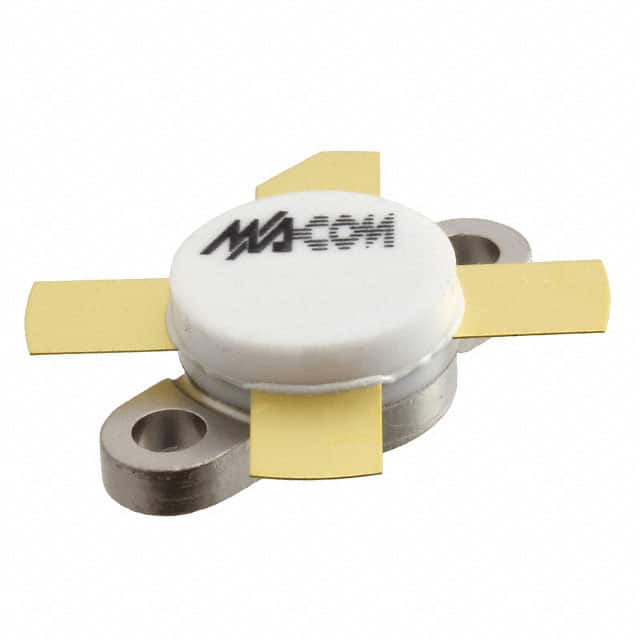Подробную информацию о продукте см. в характеристиках.

MRF151A: Encyclopedia Entry
Introduction
The MRF151A is a high-power NPN silicon bipolar transistor designed for use in industrial, commercial, and amateur radio frequency (RF) applications. This encyclopedia entry provides an overview of the MRF151A, including its product category, basic information, specifications, pin configuration, functional features, advantages and disadvantages, working principles, application field plans, and alternative models.
Product Category and Basic Information Overview
- Category: RF Power Transistor
- Use: The MRF151A is primarily used in high-power RF amplification applications, such as in RF power amplifiers and transmitters.
- Characteristics: It exhibits high power gain, excellent linearity, and robustness under high-voltage and high-current conditions.
- Package: The MRF151A is typically housed in a metal-ceramic package for enhanced thermal performance and durability.
- Essence: Its essence lies in providing reliable and efficient amplification of RF signals in high-power applications.
- Packaging/Quantity: The transistor is commonly available in industry-standard packaging and is supplied in various quantities based on customer requirements.
Specifications
- Frequency Range: 30 MHz to 512 MHz
- Output Power: Up to 150 Watts
- Voltage Rating: 50 Volts
- Current Rating: 15 Amperes
- Gain: 13 dB (typical)
- Operating Temperature: -65°C to +200°C
Detailed Pin Configuration
The MRF151A features a standard three-pin configuration: 1. Emitter (E): Connected to the ground or common reference point. 2. Base (B): Input terminal for controlling the transistor's amplification. 3. Collector (C): Output terminal for the amplified RF signal.
Functional Features
- High Power Gain: The transistor offers significant power amplification capabilities, making it suitable for high-power RF applications.
- Broad Frequency Range: It operates across a wide frequency spectrum, enabling versatility in various RF systems.
- Robust Construction: Designed to withstand high-voltage and high-current conditions, ensuring reliability in demanding environments.
Advantages and Disadvantages
Advantages
- High power gain for efficient RF signal amplification.
- Wide frequency range allows for versatile applications.
- Robust construction ensures reliability in harsh operating conditions.
Disadvantages
- Limited to lower frequency ranges compared to specialized RF transistors.
- Higher cost compared to lower-power transistors.
Working Principles
The MRF151A operates based on the principles of bipolar junction transistors (BJTs), where the input signal at the base terminal controls the flow of current between the emitter and collector terminals. This controlled current flow results in amplified RF signals at the output.
Detailed Application Field Plans
The MRF151A finds extensive use in the following application fields: - Amateur Radio: Used in high-power RF amplifiers for amateur radio enthusiasts. - Industrial RF Systems: Employed in industrial RF equipment for communication and signal amplification. - Commercial RF Transmitters: Integrated into commercial RF transmitters for broadcasting and telecommunications.
Detailed and Complete Alternative Models
- MRF150: A lower-power alternative with similar characteristics for applications requiring less output power.
- MRF1535: A higher-power alternative capable of handling greater output power levels for more demanding RF applications.
In conclusion, the MRF151A stands as a reliable and high-performance RF power transistor, catering to a wide range of high-power RF amplification needs across various industries and amateur radio enthusiasts.
Word Count: 525
Перечислите 10 распространенных вопросов и ответов, связанных с применением MRF151A в технических решениях.
What is the MRF151A?
- The MRF151A is a high-power NPN silicon RF power transistor designed for use in applications such as industrial, scientific, and medical (ISM) equipment, broadcast transmitters, and aerospace systems.
What is the maximum frequency range of the MRF151A?
- The MRF151A operates within the frequency range of 30 to 512 MHz.
What is the maximum power output of the MRF151A?
- The MRF151A can deliver up to 150 watts of power output under specified conditions.
What are the typical applications of the MRF151A?
- Typical applications of the MRF151A include RF power amplifiers, transmitters, and other high-power RF applications.
What are the key features of the MRF151A?
- The MRF151A features high power gain, high efficiency, and excellent linearity, making it suitable for demanding RF power amplifier applications.
What are the recommended operating conditions for the MRF151A?
- The MRF151A should be operated within the specified voltage, current, and temperature ranges provided in the datasheet for optimal performance and reliability.
What are the important considerations when designing with the MRF151A?
- Designers should pay attention to proper heat dissipation, impedance matching, and biasing to ensure the MRF151A operates within its safe operating limits and delivers the desired performance.
Are there any specific precautions to be taken when handling the MRF151A?
- Yes, precautions such as proper ESD protection, static control measures, and following recommended soldering and mounting procedures are important to prevent damage to the device.
Can the MRF151A be used in Class A, B, or C amplifier configurations?
- Yes, the MRF151A can be used in various amplifier classes, but the appropriate biasing and matching circuits must be implemented for each configuration.
Where can I find detailed technical information about the MRF151A?
- Detailed technical information, including electrical characteristics, thermal data, and application notes, can be found in the MRF151A datasheet provided by the manufacturer.

